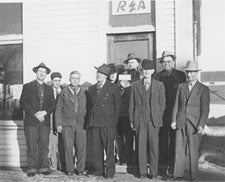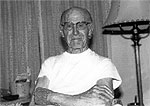Mor-Gran-Sou Electric Cooperative Inc. can attribute its success to the vision and forethought of its founding members and to those who were chosen to carry the cooperative torch since its inception.
 The humble beginnings of what is now Mor-Gran-Sou Electric Cooperative, Inc. began in 1940, when the people of rural America were learning that electric service could possibly be extended to their homes and businesses through the use of finances from a government agency known as the Rural Electrification Administration (REA). Like many rural Americans, the Flasher Commercial Club of 1940, composed of Flasher businessmen, decided that an REA-financed electric cooperative was their ticket to receiving low-cost, dependable electric service like their cousins who lived in larger cities.
The humble beginnings of what is now Mor-Gran-Sou Electric Cooperative, Inc. began in 1940, when the people of rural America were learning that electric service could possibly be extended to their homes and businesses through the use of finances from a government agency known as the Rural Electrification Administration (REA). Like many rural Americans, the Flasher Commercial Club of 1940, composed of Flasher businessmen, decided that an REA-financed electric cooperative was their ticket to receiving low-cost, dependable electric service like their cousins who lived in larger cities.
Commercial Club President C.R. Albrecht, Carl Borge, M.J. Moorhead, C.C. Shearer and R.F. Hoffman were appointed to investigate an REA project in Kindred, N.D., and, if favorable, institute such a program in the Flasher vicinity. After visiting with superintendent Strehlow of the Kindred project, the group recommended that immediate action be taken to continue and contacted the REA and begin organizational procedures.
REA Field representative Bud Carroll was sent to help with a preliminary survey of the area. E.F. Weinrich, R.H. Spielman, L.T. Craige, C.C. Shearer and Carol Borge provided volunteer transportation for Carroll to meetings held in the area. The efforts from Mor-Gran-Sou came from all areas of the three counties. This is reflected at the organizational meeting held in June of 1941 when the temporary Board of Directors was chosen.
Those chosen included: C.L. Albrecht, Flasher, president; James McGrath, Fort Rice, vice-president; Mrs. Eleanor Borge, Flasher,  secretary-treasurer; John Toman Jr., Flasher, P.G. Rausch, Raleigh; Fred P. Schones, Shields; John M. Klein, Huff; R.W. Reed, Cannonball; Walter Smith, Mandan; Weaver Colins, Fort Yates and R.B McDonald, Solen. These 13 people acted as the incorporators of the cooperative. Mor-Gran-Sou was legally incorporated under the laws of the State of North Dakota on Aug. 25, 1941.
secretary-treasurer; John Toman Jr., Flasher, P.G. Rausch, Raleigh; Fred P. Schones, Shields; John M. Klein, Huff; R.W. Reed, Cannonball; Walter Smith, Mandan; Weaver Colins, Fort Yates and R.B McDonald, Solen. These 13 people acted as the incorporators of the cooperative. Mor-Gran-Sou was legally incorporated under the laws of the State of North Dakota on Aug. 25, 1941.
The unfortunate outbreak of war in 1941 caused a delay in the realization of "rural electrification" in Morton, Grant and Sioux counties. Although Mor-Gran-Sou Electric Cooperative, Inc. saw its birth in 1941, when its Articles of Incorporation were originally filed with the secretary of state in North Dakota, activities to make Mor-Gran-Sou a provider of central-station power to the areas of Morton, Grant and Sioux counties finally materialized years later. On Dec. 6, 1945, REA approved the first loan in the amount of $210,000 to construct 173 miles of line.
Mor-Gran Sou Electric Cooperative, Inc., under the direction of Art Leno, coordinator of Rural Electric Systems, purchased the Flasher Electric Company from Hans Jorgenson in 1946, but the actual operation of the plant began in May of 1947. The first employees of Mor-Gran-Sou Electric included C.O. Stoddard, who was employed to operate the plant in May of 1947, later joined by Paul Baarstad in August of 1947. At midnight, in the month June 1948, Mor-Gran Sou Electric employees Stoddard and Baarstad witnessed the shut-down of the diesel plant that served Flasher and the start-up of a 24-hour central power station. Arnold Ketterling was employed by Mor-Gran-Sou Electric in September of 1948 as the organizations first Office Manager.
 Carl Albrecht was the first member of Mor-Gran-Sou Electric Cooperative, Inc. The first farm service to receive electricity was that of Herbert Friese of New Salem on May 29, 1948. The last area to receive service was Sioux County. The generating plants at Shields, Solen and Fort Yates were purchased in 1952, with the contract completion date of January 1953.
Carl Albrecht was the first member of Mor-Gran-Sou Electric Cooperative, Inc. The first farm service to receive electricity was that of Herbert Friese of New Salem on May 29, 1948. The last area to receive service was Sioux County. The generating plants at Shields, Solen and Fort Yates were purchased in 1952, with the contract completion date of January 1953.
What has come to light in the 21st Century is the visionary development of long-term reliable electric service to the region. Mor-Gran-Sou Electric, working with the Bureau of Reclamation, was a key player in the development of the hydroelectric resources associated with the dams along the Missouri River. In the 1940s and 1950s, the Garrison dam was in the initial planning phase as part of the Pick-Sloan Project. As part of the benefit from the flooding of farmland, it was determined that the electrical generation from these dams should go to rural areas. Because of this philosophy of the Rural Electric Cooperatives, irrigation Districts and Municipal Utilities were allocated portions of the generation output. They became what are known today as Preference Customers.
In the beginning Preference Customers purchased power from the Bureau of Reclamation, which was responsible for operating the dams. In later years, the generation of electricity and the transmission of the power were split. A new organization, known as the Western Area Power Administration, was formed to manage the transmission of electrical power. The vision, demonstrated by signing long-term power agreements for the energy, has contributed to the success of Mor-Gran-Sou. This vision came forth again in the late 1950s.
During the later years of the 1950s, the Bureau of Reclamation determined the existing hydroelectric facilities were not going to meet the ever-increasing consumer demands. The electric cooperatives of the region felt that it was in their best interest to take control over their long-term power supplies came together to create a transmission and generation system. The result of this concept was the birth of Basin Electric Power Cooperative in 1961.
Today Mor-Gran-Sou Electric receives approximately 21 percent of its annual electrical needs from the Western Area Power Administration, whose corporate office is based in Lakewood, Colo., with the balance of needed power purchased through an All Power Requirements Contract from Basin Electric Power Cooperative, with headquarters in Bismarck, N.D.
At its inception, Mor-Gran-Sou Electric Cooperative, Inc. largely served farm and ranch loads. Today we still serve these, in addition to many other types of members. Our fastest-growing type of load is the residential home, located in housing subdivisions. In recent years Mor-Gran-Sou Electric has tipped the scale and serves more urban than rural members.
Mor-Gran-Sou Electric grew as the employee base and member/owners' demands grew. By 1952, the original office building and storerooms that the personnel operated from were now inadequate. In February of that year, a steel Quonset was purchased to provide temporary office and warehouse space. The main office building, located at 202 6th Ave. W. was completed June of 1955. The old light plant building and lots were sold in 1956. In 1979 another addition was added to the existing headquarter building.
The role of management has played a key role in the successes Mor-Gran-Sou Electric experienced. As mentioned, Art Leno, under the title of coordinator of rural electric systems, worked for the cooperative until April 1949, when he resigned his position with Mor-Gran-Sou and on May 16, 1949, Wallace Timpe assumed the position of manager. On Dec. 1, 1969, Wallace Timpe passed the management torch to John W. Allen. Allen remained at the helm of Mor-Gran-Sou until Jan. 1, 1989, when John L. Sims was hired as general manager. Allen's official retirement date was Jan. 20, 1989. Manager Sims resigned on March 4, 1994. Connie Rossow was selected as interim manager until Aug. 1, 1994, when Donald A. Franklund was hired as general manager/CEO.
On Jan. 1, 2008, a management alliance called Innovative Energy Alliance (IEA), LLC., was formalized. The co-general managers/CEOs were Donald A. Franklund and Clayton Hoffman. The alliance is currently managed by Co-General Managers/CEOs Donald A. Franklund and Travis Kupper. It provides management services to Mor-Gran-Sou Electric Cooperative, Inc., Roughrider Electric Cooperative, Inc., Slope Electric Cooperative, Inc., and KEM Electric Cooperative, Inc. IEA also provides management services to 3C Construction, LLC, West Dakota Utility Services and Maintenance Solutions Cooperative. IEA has an office at the J&L building in Bismarck. In November 2016, Innovative Energy Alliance, LLC converted to Innovative Energy Alliance Cooperative.
Currently, Mor-Gran-Sou Electric employees are housed at three different locations including the Mandan Service Center at 2719 34th St NW; the Fort Yates Service Center and warehouse located at 9714 Highway 24 in Fort Yates; and the Mor-Gran-Sou Electric headquarters located in Flasher.
The board, management and employees of Mor-Gran-Sou Electric are committed to providing solutions for the needs of today and tomorrow's members. Our history provides us a glimpse into the past, while our vision for tomorrow provides us an opportunity to leave a legacy for those in the future.

